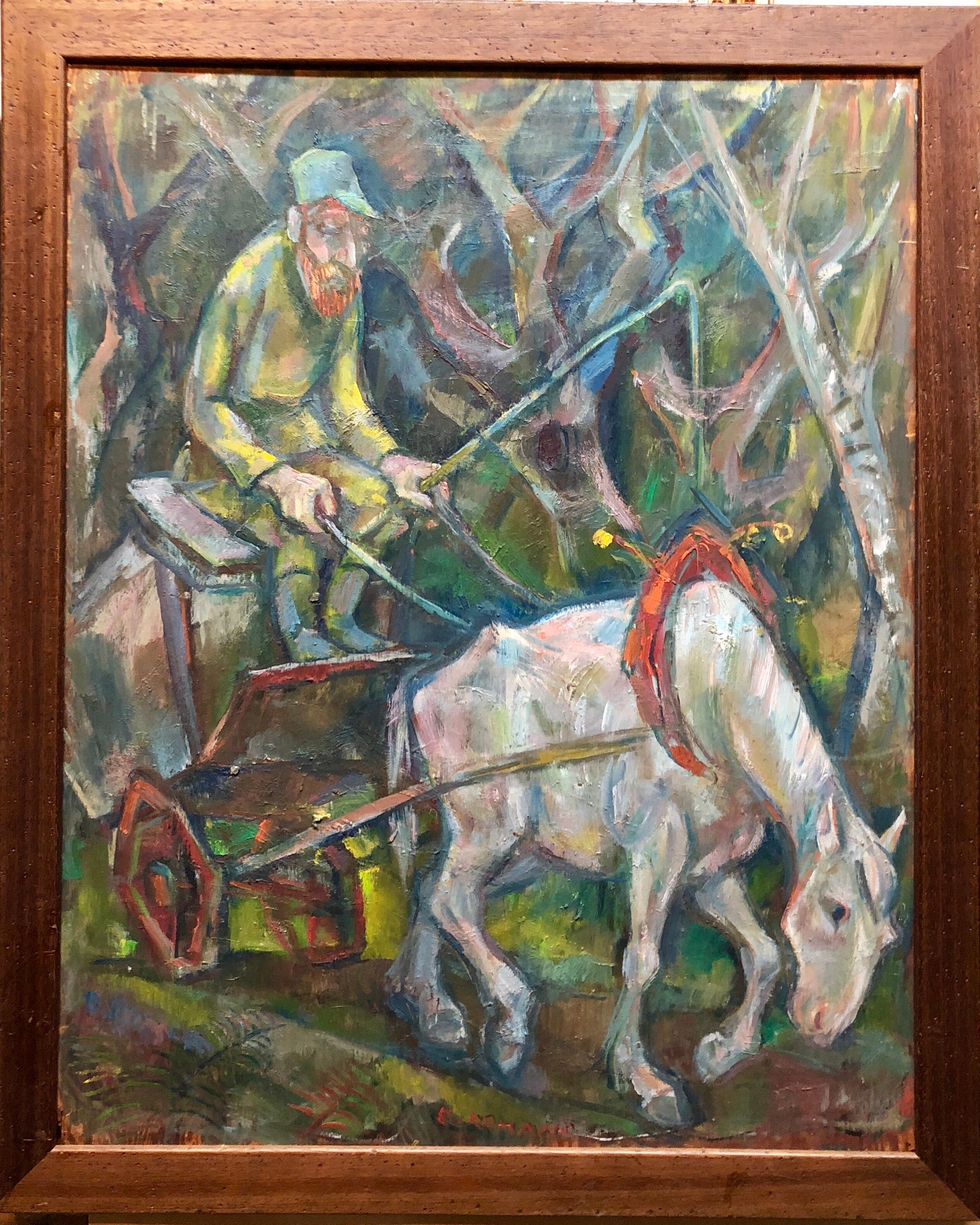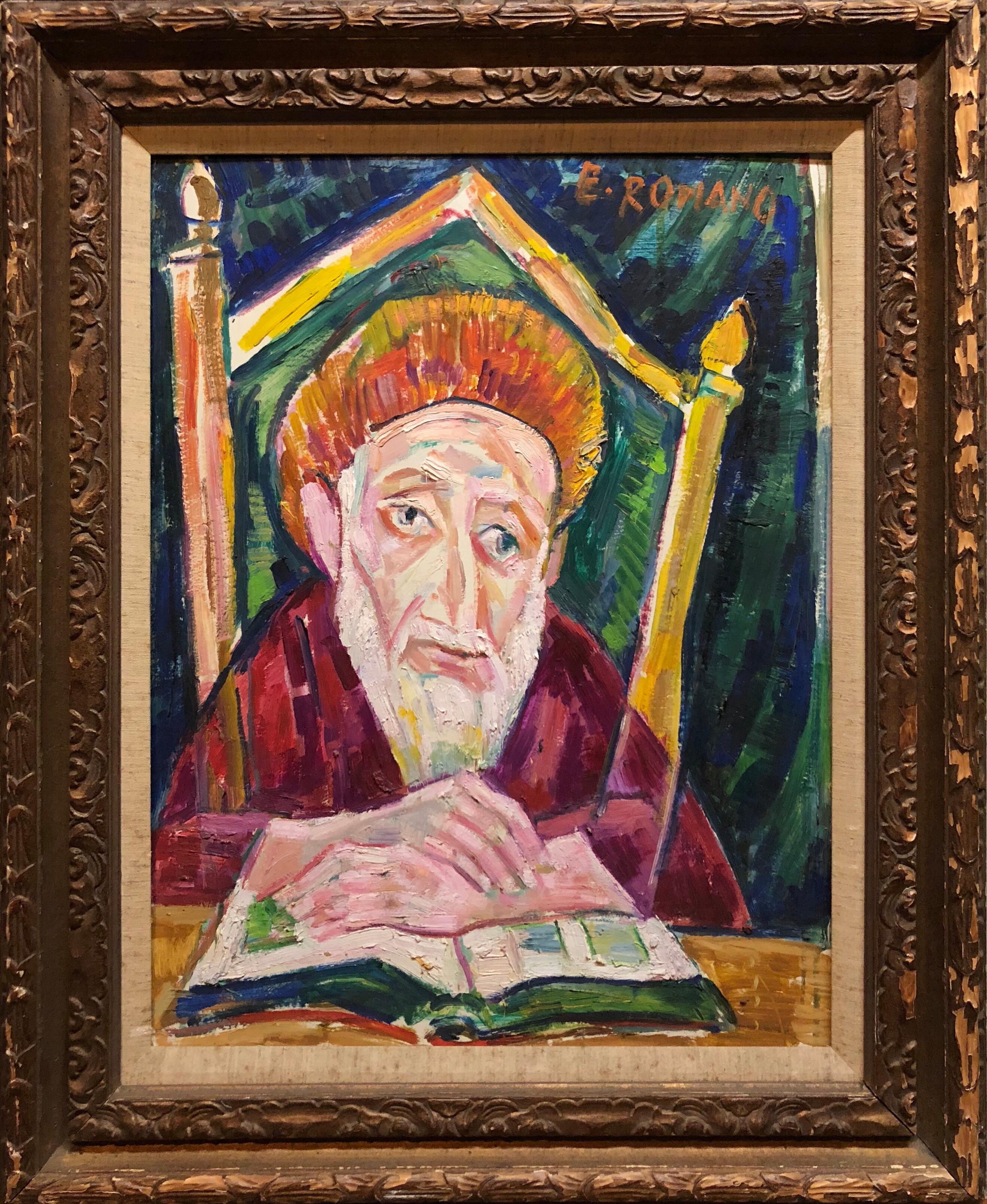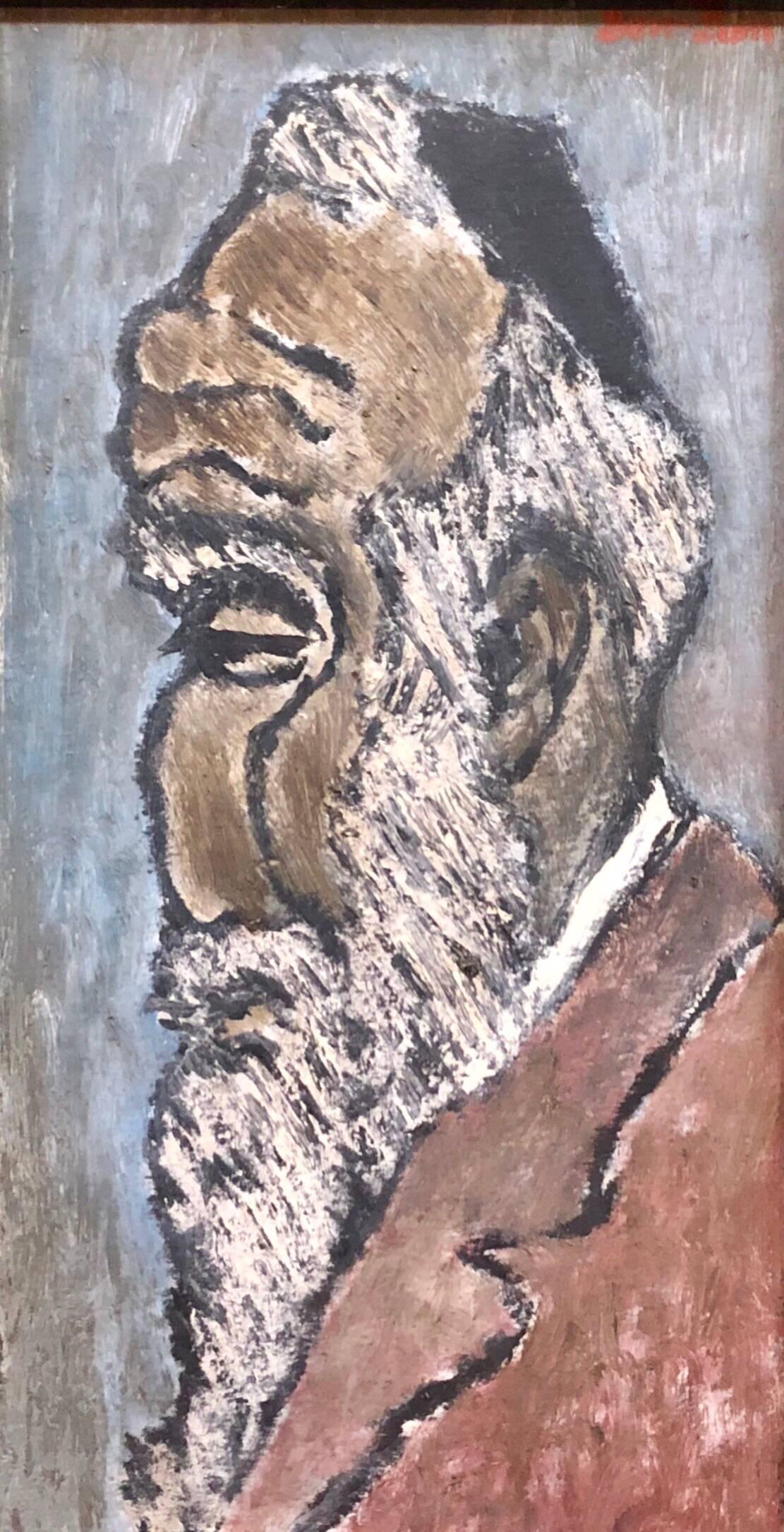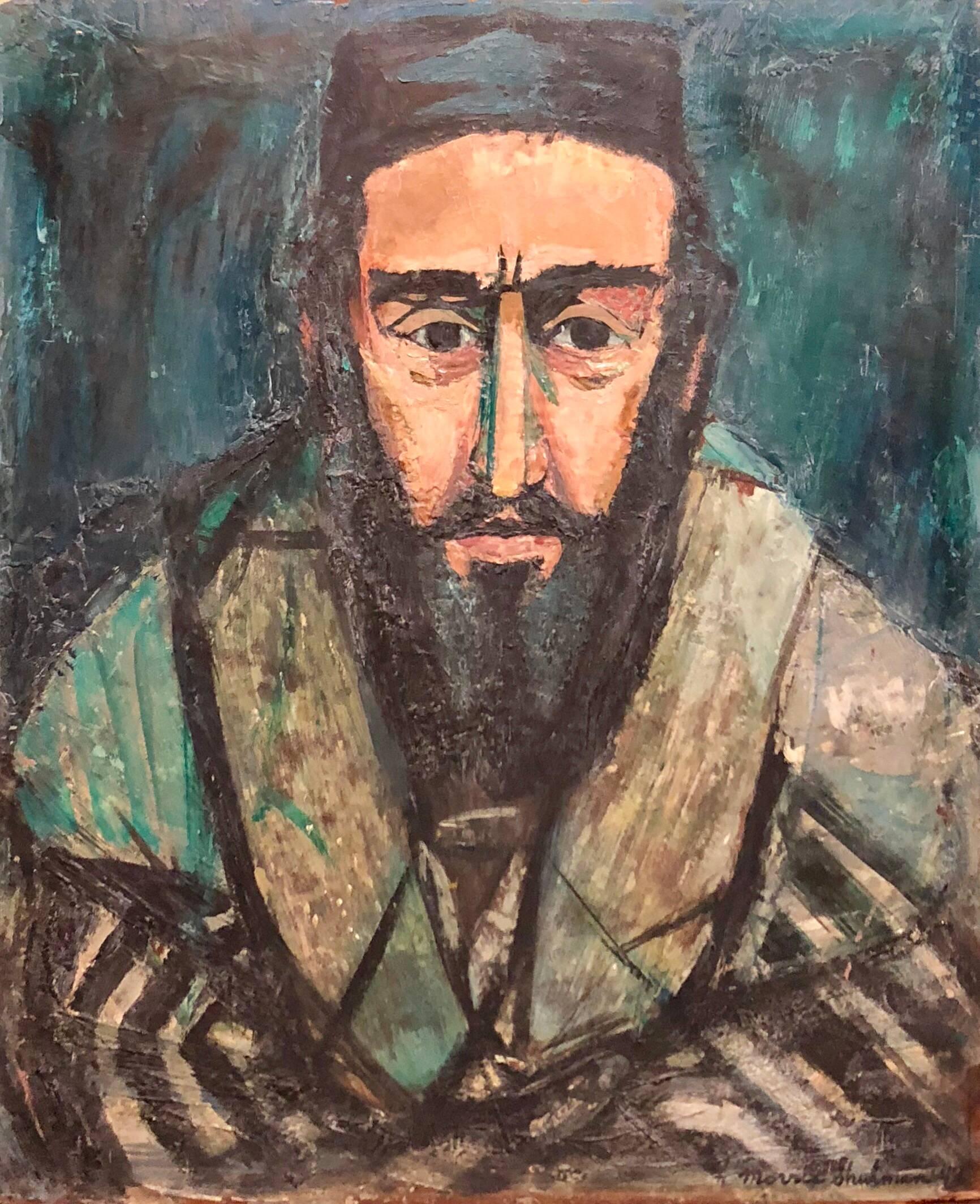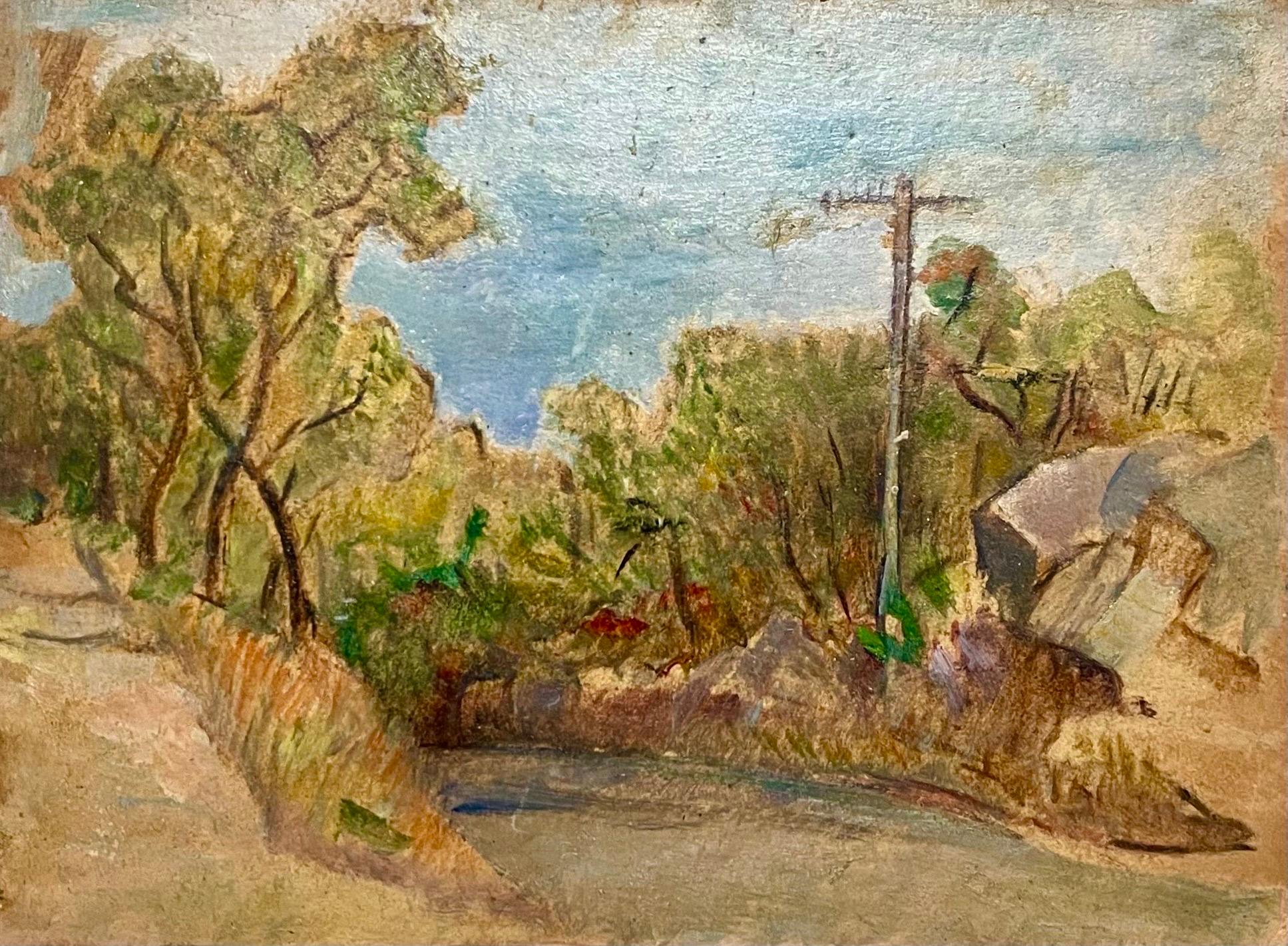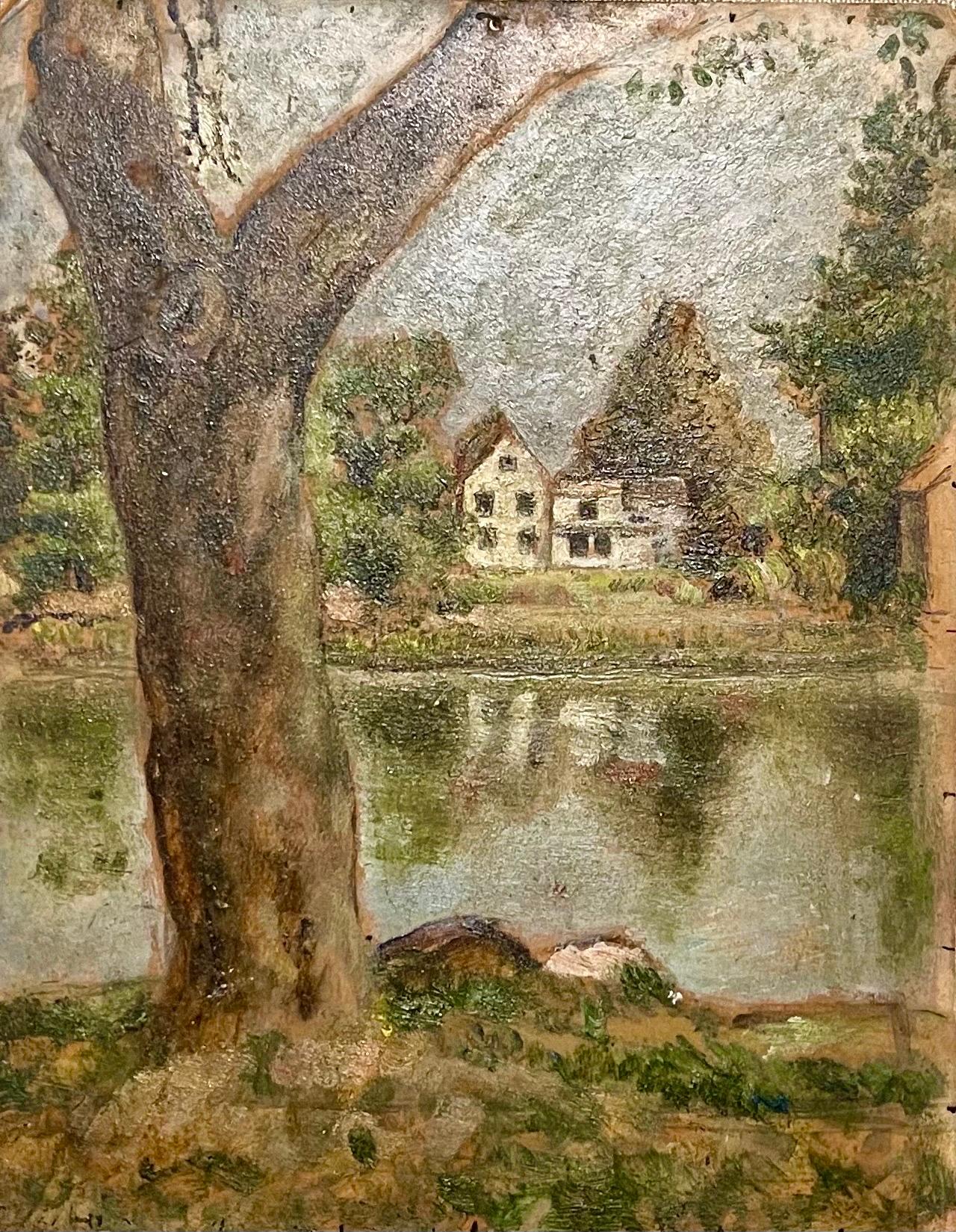Items Similar to The Jury
Want more images or videos?
Request additional images or videos from the seller
1 of 10
Mervin JulesThe Juryc. 1940's
c. 1940's
About the Item
MERVIN JULES (1912-1994)
The Jury, c.1940’s
Oil on board
14 x 15 1/8 inches
Signed at lower left: JULES
PROVENANCE
ACA Galleries, New York, NY
EXHIBITED
Cahoon Museum of American Art, Cotuit, Massachusetts, Tell Me a Story – Chapter 2, Narrative Art of the Cape and Islands, July 17 – September 15, 2001.
A painter, illustrator, print maker, and educator, Mervin Jules was known for painting and illustration that focused on social commentary and that often employed satire.
He was active as a print maker, having been a designer of silk prints and a china painter as a young man growing up in Baltimore. During the Depression of the 1930s, he was a member of the Silk Screen Unit of the Fine Arts Project of the WPA.
Jules studied art at Baltimore City College, and on scholarship at the Maryland Institute of Fine and Applied Arts where he graduated in 1934. In 1937, he enrolled at the Art Students League with Thomas Hart Benton. He had his first one-man exhibition in November, 1937 in New York City, and in this show had small tempera panels, and a series of Pennsylvania coal-country theme gouache paintings.
Teaching positions included the Fieldston School, and the Museum of Modern Art in New York City from 1943 to 1946; the Baltimore Educational Alliance; and Smith College in Northampton, Massachusetts from 1946 to 1969. Upon leaving Smith, he became Chair of the Art Department of the City College of New York, and also maintained a studio in Provincetown, Massachusetts.
Memberships included the Provincetown Art Association, Audubon Artists, American Art Congress, and United American Artists.
Exhibition Venues:
"Baltimore Museum of Art, 1936-46; Whitney Museum of American Art, 1938, 1940-49; Art Institute of Chicago, 1938-41; Pennsylvania Academy of the Fine Arts annual, 1939, 1943, 1948-50; Museum of Modern Art, 1941 (prize); "World's Fair, New York", 1939; Golden Gate Exposition, 1939; Carnegie Institute, 1941, 1944-45; Virginia Museum of Fine Arts, 1946; Library of Congress, 1940, 1945-46; Library of Congress, 1945; Brooklyn Museum; Corcoran Gallery of Art biennial, 1945; ACA Gallery, New York City, 1940s; San Francisco World's Fair; American American Artists for Victory (sent to England); Boston Printmakers, 1967 (19th annual Exhibition, honorable mention ). Awards: Asian-African Study Program grant to Japan, 1967; Alfred Vance Churchill Foundation grant, 1967.
- Creator:Mervin Jules (1912 - 1994, American)
- Creation Year:c. 1940's
- Dimensions:Height: 14 in (35.56 cm)Width: 15.25 in (38.74 cm)
- Medium:
- Movement & Style:
- Period:
- Condition:
- Gallery Location:Concord, MA
- Reference Number:1stDibs: LU354752162
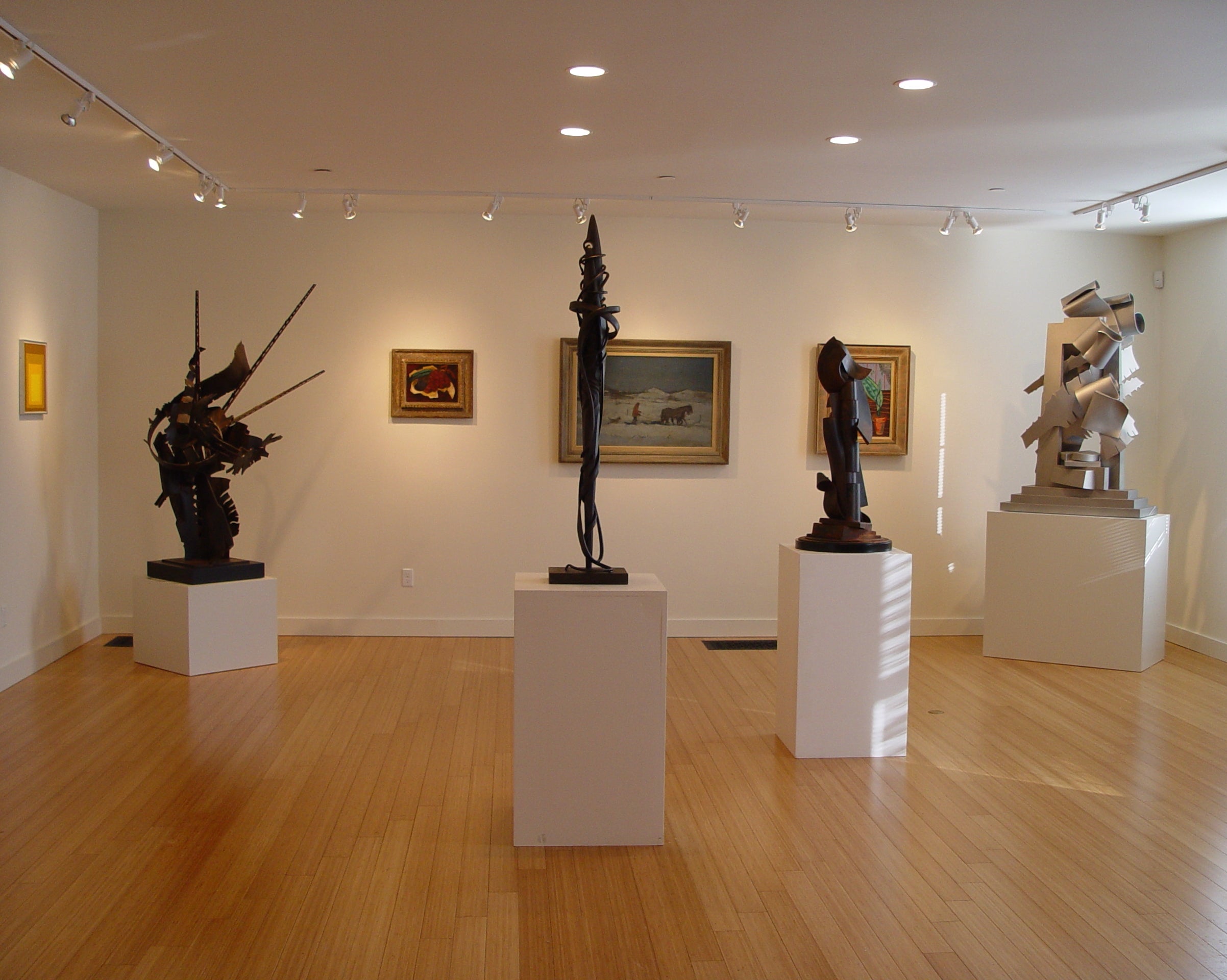
About the Seller
4.4
Vetted Seller
These experienced sellers undergo a comprehensive evaluation by our team of in-house experts.
Established in 1993
1stDibs seller since 2014
50 sales on 1stDibs
- ShippingRetrieving quote...Ships From: Concord, MA
- Return PolicyThis item cannot be returned.
More From This SellerView All
- Seeking a FutureBy Philip EvergoodLocated in Concord, MAPHILIP EVERGOOD (1901-1973) Seeking a Future, 1952 Oil on canvas 24 x 18 inches Signed and dated at lower left: Philip Evergood / 52 Heydenryk frame PROVENANCE Alfredo Valent...Category
1950s American Modern Figurative Paintings
MaterialsOil, Canvas
- The FactoryBy Gregorio PrestopinoLocated in Concord, MAGREGORIO PRESTOPINO (1907-1984) The Factory, c. 1935 Oil on canvas 30 x 24 inches Signed at lower left: Prestopino Born in the Little Italy section of New York City, Prestopino was awarded a scholarship to the National Academy of Design at the age of fourteen. Early in his career he came under the influence of the French Impressionists, but was soon drawn to the American realists of the Ashcan School, whose work led him directly to the study of urban life. As a young man Prestopino set up his first studio in Harlem. During the 1930s his social realist paintings had an anecdotal quality in their description of everyday incidents of the working class, depicting the grit of city life – docks, laborers, vendors, Lower East Side streets. Prestopino lived in Brooklyn for many years, spending summers at a farm near Clinton, New Jersey. At the farm Prestopino painted in the barn, while his wife - illustrator Elizabeth Dauber - had a studio in the house. He moved to Roosevelt, New Jersey in 1949. Other artists who have lived in Roosevelt include Ben and Bernarda Shahn, their son Jonathan Shahn, Jacob Landau, David Stone Martin and his son, Stefan Martin...Category
1930s American Modern Figurative Paintings
MaterialsOil, Canvas
- Strong ManBy Walter QuirtLocated in Concord, MAWALTER QUIRT Strong Man, c. 1939-40 Oil on masonite 2 1/16 x 2 1/8 inches Signed at lower right: QUIRT Titled verso Oxidized metal frame (possibly silver) ...Category
1930s Surrealist Figurative Paintings
MaterialsOil
- Woman and Rock, 1975By Scott PriorLocated in Concord, MASCOTT PRIOR (born 1949) Woman and Rock, 1975 Oil on masonite 11 x 13 3/8 inches Signed and dated verso: Prior 1975 Framed PROVENANCE The artist Ann and Graham Gund, Cambridge, Mas...Category
1970s American Realist Figurative Paintings
MaterialsOil
- Goldie’s DreamBy Gregory GillespieLocated in Concord, MAGREGORY GILLESPIE (1936-2000) Goldie’s Dream, 1999 Oil on panel 20 1/8 x 19 5/8 inches Signed verso: Greg Gillespie Original frame PROVENANCE Forum Gallery, New York, New York (label verso) Nielson Gallery, Boston, Massachusetts (label verso) EXHIBITED Forum Gallery, New York, Gregory Gillespie: New Works, December 2 - 31, 1999 Gregory Gillespie, an artist whose probing, urgent, often bizarre paintings occupied a singular place in the history of late-20th-century representational art committed suicide in 2000 at the age of sixty-four. His art was known for an obsessive attention to realistic detail, but the term realist fit only a narrow swath of his sensibility. He once told an interviewer that he was seeking a reality ''beyond our sense,'' and he pursued it with a variety of artistic styles, techniques and references. He mixed his realism with Expressionist distortion and Surrealistic juxtaposition, just as he supplemented his meticulously applied oil paint with roiling brushwork, photomontage, collage, assemblage, thickly built-up surfaces and, recently, photocopied images. He also found inspiration in several centuries of European painters, including Balthus, Bacon, Beckmann, Bosch, Breugel, Van Eyck, Masaccio and Crivelli. He drew from, and frequently depicted motifs from, Indian sculpture, Tibetan mandalas...Category
1990s Surrealist Figurative Paintings
MaterialsPanel, Oil
- Frances and Ruth Jennings in a Field of FlowersLocated in Concord, MAMABEL E. DICKINSON POND (1869-1960) Frances and Ruth Jennings in a Field of Flowers, 1909 Oil on canvas on paperboard 7 x 5 inches Signed at lower right: M. E. Dickinson Inscribed v...Category
Early 1900s American Impressionist Figurative Paintings
MaterialsOil
You May Also Like
- Large Modernist Oil Painting 1940s, Judaica Hasidic Shtetl Wagon Driver WPA EraBy Emanuel Glicenstein RomanoLocated in Surfside, FLGenre: Modern Subject: Landscape with figure of horse, driver and wagon Medium: Oil Surface: wood Board EMANUEL ROMANO Rome, Italy, b. 1897, d. 1984 Emanuel Glicen Romano was born in Rome, September 23, 1897. His father Henryk Glicenstein was a sculptor and was living in Rome with his wife Helena (born Hirszenberg) when Emanuel was born. His father obtained Italian citizenship and adopted the name Enrico. Emanuel was brought up in Italy, Switzerland, Germany, England and Poland. In 1926 Emanuel Glicenstein Romano and his father sailed for New York. They briefly visited Chicago. Romano's sister, Beatrice, and mother only joined them in New York years later. Romano changed his name on his arrival to America and some have erroneously speculated that this was to avoid antisemitic discrimination. In truth, as the son of a highly-regarded artist, Romano changed his name to ensure that any success or recognition he would later attain, would be the result of nothing other than his own merit as an artist, and not on account of his father's fame. In 1936 Romano was worked for the WPA Federal Art Project creating murals. ( there were many jewish artists active with in the WPA period. notably Chaim Gross, Ben Shahn, Isaac and Moses Soyer, Abraham Rattner and many others. During and immediately after World War II, Romano created a series of allegorical works depicting graphic holocaust images that were held closely by the family until after his passing. One of these works is now on permanent display in the Florida Holocaust Museum in St. Petersburg Florida. Emanuel's father died in 1942 in a car accident before they could realize their shared dream of visiting Israel. In 1944 Romano, having completed his degree at the Pennsylvania Academy of Fine Arts and the Art Institute of Chicago, began teaching at the City College of New York. Romano moved to Safed, Israel in 1953 and established an art museum in his father's memory, the Glicenstein Museum. COLLECTIONS Indianapolis Museum of Art Metropolitan Museum of Art Boston Fine Arts Museum Fogg Museum Musée Nacional de France Recently his work has been added to the Florida Holocaust Museum collection. His notable works include his holocaust themed allegorical paintings as well as portraits of Marianne Moore, his father and William Carlos Williams...Category
1930s American Modern Figurative Paintings
MaterialsOil, Board
- Modernist Oil Painting 1940s, Judaica Hasidic Rabbi in JerusalemBy Emanuel Glicenstein RomanoLocated in Surfside, FLGenre: Portrait Subject: Landscape Medium: Oil Surface: Board Country: United States EMANUEL ROMANO Rome, Italy, b. 1897, d. 1984 Emanuel Glicenstein Romano was born in Rome, September 23, 1897. His father Henryk Glicenstein was a sculptor and was living in Rome with his wife Helena (born Hirszenberg) when Emanuel was born. His father obtained Italian citizenship and adopted the name Enrico. Emanuel was brought up in Italy, Switzerland, Germany, England and Poland. In 1926 Emanuel and his father sailed for New York. They briefly visited Chicago. Romano's sister, Beatrice, and mother only joined them in New York years later. Romano changed his name on his arrival to America and some have erroneously speculated that this was to avoid antisemitic discrimination. In truth, as the son of a highly-regarded artist, Romano changed his name to ensure that any success or recognition he would later attain, would be the result of nothing other than his own merit as an artist, and not on account of his father's fame. In 1936 Romano was worked for the Federal Art Project creating murals. During and immediately after World War II, Romano created a series of allegorical works depicting graphic holocaust images that were held closely by the family until after his passing. One of these works is now on permanent display in the Florida Holocaust Museum in St. Petersburg Florida. Emanuel's father died in 1942 in a car accident before they could realize their shared dream of visiting Israel. In 1944 Romano, having completed his degree at the Pennsylvania Academy of Fine Arts and the Art Institute of Chicago, began teaching at the City College of New York. Romano moved to Safed, Israel in 1953 and established an art museum in his father's memory, the Glicentein Museum. COLLECTIONS Indianapolis Museum of Art Metropolitan Museum of Art Boston Fine Arts Museum Fogg Museum Musée Nacional de France Recently his work has been added to the Florida Holocaust Museum collection. His notable works include his holocaust themed allegorical paintings as well as portraits of Marianne Moore, his father and William Carlos Williams...Category
1970s American Modern Figurative Paintings
MaterialsOil, Board
- Modernist Judaica Oil Painting "Old Jew" Jewish Rabbi at PrayerBy Ben-Zion WeinmanLocated in Surfside, FLAn oil on board Judaic painting by modern artist Ben-Zion Weinman. It depicts a portrait in profile of an old Jew. The work is signed "Ben-Zion". Born in 1897, Ben-Zion Weinman celebrated his European Jewish heritage in his visual works as a sculptor, painter, and printmaker. Influenced by Spinoza, Knut Hamsun, and Wladyslaw Reymont, as well as Hebrew literature, Ben-Zion wrote poetry and essays that, like his visual work, attempt to reveal the deep “connection between man and the divine, and between man and earth.” An emigrant from the Ukraine, he came to the US in 1920. He wrote fairy tales and poems in Hebrew under the name Benzion Weinman, but when he began painting he dropped his last name and hyphenated his first, saying an artist needed only one name. Ben-Zion was a founding member of “The Ten: An Independent Group” The Ten” a 1930’s avant...Category
1940s American Modern Figurative Paintings
MaterialsOil, Board
- Judaica Rabbi Portrait Oil Painting American WPA Abstract Expressionist ArtistBy Morris ShulmanLocated in Surfside, FLBorn in Savannah, Georgia in 1912, abstract expressionist painter Morris Shulman studied at the National Academy of Design, Art Students League and Hans Hofmann School of Art in New ...Category
1940s American Modern Portrait Paintings
MaterialsEncaustic, Oil, Board
- Simka Simkhovitch WPA Artist Oil Painting Gouache American Modernist PowerlineBy Simka SimkhovitchLocated in Surfside, FLSimka Simkhovitch (Russian/American 1893 - 1949) This came with a small grouping from the artist's family, some were hand signed some were not. These were studies for larger paintings. Simka Simkhovitch (Симха Файбусович Симхович) (aka Simka Faibusovich Simkhovich) (Novozybkov, Russia May 21, 1885 O.S./June 2, 1885 N.S.—Greenwich, Connecticut February 25, 1949) was a Ukrainian-Russian Jewish artist and immigrant to the United States. He painted theater scenery in his early career and then had several showings in galleries in New York City. Winning Works Progress Administration (WPA) commissions in the 1930s, he completed murals for the post offices in Jackson, Mississippi and Beaufort, North Carolina. His works are in the permanent collections of the Dallas Museum of Art, the National Museum of American Art and the Whitney Museum of American Art. Born outside Kyiv (Petrograd Ukraine) into a Jewish family who owned a small department store. During a severe case of measles when he was seven, Simcha Simchovitch sketched the views outside his window and decided to become an artist, over his father's objections. Beginning in 1905, he studied at the Grekov Odessa Art School and upon completion of his studies in 1911 received a recommendation to be admitted to the Imperial Academy of Arts. Though he enrolled to begin classes in architecture, painting, and sculpture at the Imperial Academy, he was dropped from the school roster in December because of the quota on the number of Jewish students and drafted into the army. Simchovitch served as a private in the 175th Infantry Regiment Baturyn [ru] until his demobilization in 1912. Re-enrolling in the Imperial Academy, he audited classes. Simka Simkhovitch exhibited paintings and sculptures in 1918 as part of an exhibition of Jewish artists and in 1919 placed 1st in the competition "The Great Russian Revolution" with a painting called "Russian Revolution" which was hung in the State Museum of Revolution. In 1922, Simkha Simkhovitch exhibited at the International Book Fair in Florence (Italian: Fiera Internazionale del Libro di Firenze). In 1924, Simkhovitch came to the United States to make illustrations for Soviet textbooks and decided to immigrate instead. Initially he supported himself by doing commercial art and a few portrait commissions. In 1927, he was hired to paint a screen for a scene in the play "The Command to Love" by Fritz Gottwald and Rudolph Lothar which was playing at the Longacre Theatre on Broadway. Art dealers began clamoring for the screen and Simkhovitch began a career as a screen painter for the theater. Catching the attention of the screenwriter, Ernest Pascal, he worked as an illustrator for Pascal, who then introduced him to gallery owner, Marie Sterner. Simkhovitch's works appeared at the Marie Sterner Gallery beginning with a 1927 exhibit and were repeated the following year. Simkhovitch had an exhibit in 1929 at Sterner's on circus paintings. In 1931, he held a showing of works at the Helen Hackett Gallery, in New York City and later that same year he was one of the featured artists of a special exhibit in San Francisco at the California Palace of the Legion of Honor in Lincoln Park. The exhibit was coordinated by Marie Sterner and included four watercolors, including one titled "Nudes". He is of the generation of Russian Soviet artists such as Isaac Pailes, Serge Charchoune, Marc Chagall, Chana Orloff, Isaac Ilyich Levitan, and Ossip Zadkine. In 1936, Simkhovitch was selected to complete the mural for the WPA Post office project in Jackson, Mississippi. The mural was hung in the post office and courthouse in 1938 depicted a plantation theme. Painted on the wall behind the judge’s bench, “Pursuits of Life in Mississippi”, a depiction of black workers engaged in manual labor amid scenes of white professionals and socialites, was eventually covered over in later years during renovations due to its stereotypical African American imagery. Simka painted what he thought was typical of Jackson. His impression of pre-civil rights Mississippi was evidently Greek Revival column houses, weeping willow trees, working class families, and the oppression of African Americans. He painted African American men picking cotton, while a white man took account of the harvest and a white judge advised a white family, calling it Pursuits of Life in Mississippi. Though clearly endorsed by the government and initially generally well-received, the mural soon raised concerns with locals as the climate toward racial segregation began to change. The main concern was whether depictions that show African Americans in subjugated societal roles should be featured in a courtroom. The following year, his painting "Holiday" won praise at an exhibition in Lincoln, Nebraska. In 1940, Simkhovitch's second WPA post office project was completed when four murals, "The Cape Lookout Lighthouse and the Orville W. Mail Boat", "The Wreck of the Crissie Wright", "Sand Ponies" and "Canada Geese" were installed in Beaufort, North Carolina. The works were commissioned in 1938 and did not generate the controversy that the Jackson mural had. The main mural is "The Wreck of the Crissie Wright" and depicts a shipwreck which had occurred in Beaufort in 1866. "The Cape Lookout Lighthouse and the Orville W. Mail Boat" depicted the lighthouse built in 1859 and the mail boat that was running mail during the time which Simkhovitch was there. The boat ran mail for the area until 1957. "Sand Ponies" shows the wild horses common to the North Carolina barrier islands and "Canada Geese" showed the importance of hunting and fishing in the area. All four murals were restored in the 1990s by Elisabeth Speight, daughter of two other WPA muralists, Francis Speight...Category
1930s American Modern Landscape Paintings
MaterialsGouache, Oil, Board
- Simka Simkhovitch WPA Artist Oil Painting American Modernist Landscape Pond TreeBy Simka SimkhovitchLocated in Surfside, FLSimka Simkhovitch (Russian/American 1893 - 1949) This came with a small grouping from the artist's family, some were hand signed some were not. Thes...Category
1930s American Modern Landscape Paintings
MaterialsOil, Board
Recently Viewed
View AllMore Ways To Browse
The Modern Library Of The
1940S Vintage Fairs
1940s Library
American School Maryland
American School Baltimore
American Silk Screen
Golden Gate Painting
Golden Chinese Painting
19th Japan Silk Paint
50s Illustration Art
C Hart
1946 Chinese
African American Screen
1940s Oil On Panel
Japanese Modern Silk Screen
Japanese Chinese Painting Silk
1930s Wpa Prints
Painted Pennsylvania Chair
